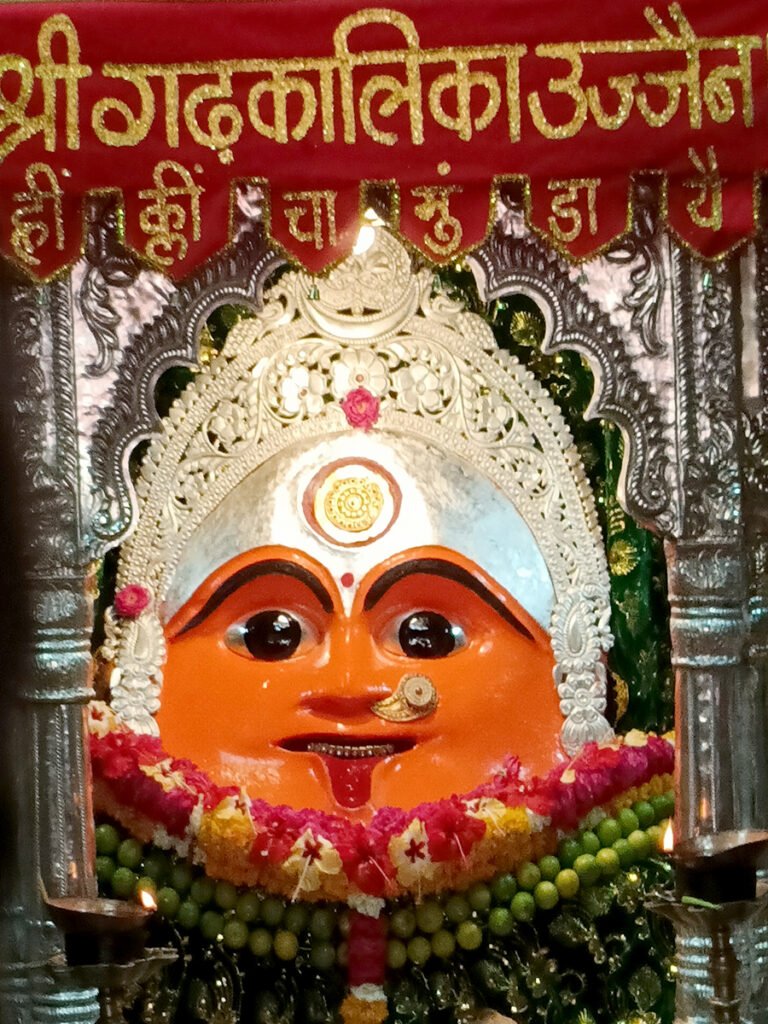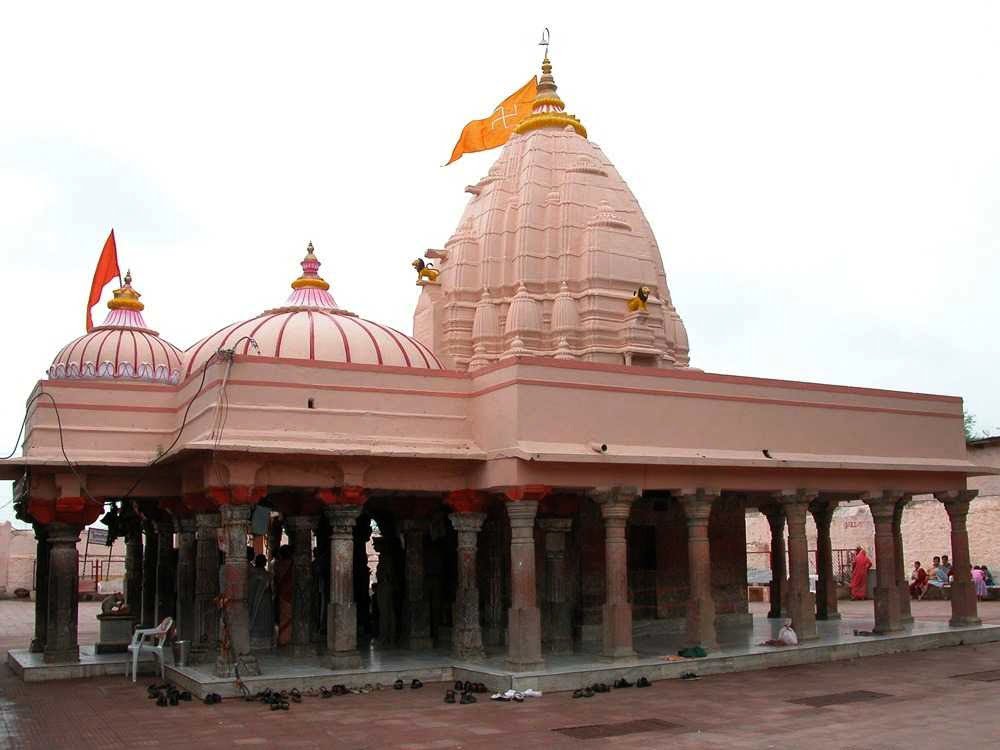Avanti Maa Gadkalika Temple Ujjain
Avanti Maa Gadkalika Temple in Ujjain in local is one of the 51 Shakti Peethas located on Bhairavparvat on the banks of Shipra River, Ujjain, India. Here Avanti maa is also called Shri Maha Kali, the Bhairav form of Lord Shiva is Lambkarna. It is one of the ancient temples in India, it is believed to be a 5000-year-old temple. Goddess is also one among Ashtadasa Peethas. Goddess is one among three deities Maha Kali (middle), Maha Lakshmi, and Maha Saraswathi.

Contents
- 1 Significance of Avanti Maa Gadkalika Temple:
- 2 Legend of Avanti Maa Gadkalika Temple:
- 3 Rituals and offerings at Avanti Maa Gadkalika Temple:
- 4 Places to visit near Avanti Maa Gadkalika Temple:
- 5 FAQ:
- 5.0.1 Where is Avanti Maa Gadkalika Temple located?
- 5.0.2 What is the significance of the Avanti Maa Gadkalika Temple?
- 5.0.3 How do I reach the Avanti Maa Gadkalika Temple?
- 5.0.4 Is there an entry fee to the temple?
- 5.0.5 What is the best time to visit the Avanti Maa Gadkalika Temple?
- 5.0.6 What are the temple’s opening hours?
- 5.0.7 Are there any specific dress code or guidelines for visitors?
- 5.0.8 Can non-Hindus visit the temple?
- 5.0.9 Are there facilities for food and accommodation near the temple?
- 5.0.10 Is photography allowed inside the temple?
- 6 How to reach Avanti Maa Gadkalika Temple:
- 7 Google Maps:
Significance of Avanti Maa Gadkalika Temple:
- According to the mythology Daksha yagna and Sati self-immolation, it is the holy place where the “Upper lip” fell down.
- It is one of the 7 moksha places on earth
Legend of Avanti Maa Gadkalika Temple:
Once there was a demon named Andhakalesahwar who created havoc in all worlds. He had a boon from Lord Brahma that wherever his blood shreds, there will be his form of demons generated. In order to protect all worlds, Adhi parashakti took the form of Kali and during the fight goddess spread her tongue and absorbed all the blood came out of the demon and killed the demon.
In another context, it is the place where Kalidasa got knowledge by the grace of the goddess. It is believed that the goddess wrote a text on the tongue of Kalidasa.
In garbha gudi we find goddess Avanti idol stretching tongue. In Devi Bhagavatam, Gad Kalika maa is treated as the goddess of graha kalika. According to Skanda Purana king, Ashoka married the bride of this city and made Avanthi his capital city for ruling. Also, Ujjain means the birthplace of the religion Jain. King Sudhanva changed his religion to Jain and changed the name of Avanti to Ujjain.
Explore More>> Narmada Devi Shondesh Shakti Peeth

Rituals and offerings at Avanti Maa Gadkalika Temple:
Rituals:
Darshan (Temple Visit): Devotees visit the temple to have darshan (sight) of Goddess Kalika. It is believed that by looking at the deity, one can seek her blessings.
Aarti: Regular aarti ceremonies are performed at the temple. Devotees participate in these aarti sessions, which involve singing devotional songs and offering lighted lamps to the goddess.
Bhajans and Kirtans: Devotees often engage in singing devotional songs and bhajans in praise of the goddess. These sessions create a spiritually uplifting atmosphere.
Offering Flowers: It is customary to offer fresh flowers to the goddess as a symbol of devotion and love. The fragrance and beauty of the flowers are believed to please the deity.
Prasad Distribution: Devotees often bring prasad (offerings) such as sweets, fruits, and other vegetarian food items. After offering these items to the goddess, they are distributed among the devotees as a blessed food.
Special Pujas: Some devotees may choose to perform special pujas and rituals for specific purposes, such as for the well-being of their families, success in endeavors, or personal wishes. These pujas are often performed with the assistance of temple priests.
Meditation and Prayer: Many visitors come to the temple to meditate and offer personal prayers to the goddess, seeking her guidance and blessings in their lives.
Explore More>> Gandaki Shakti Peeth Muktinath Temple
Offerings:
Coconut: Coconuts are considered a favorite offering to Goddess Kalika. Devotees often offer whole coconuts or just the coconut water as a symbol of purity.
Sindoor (Vermilion): Sindoor is a red powder that is applied to the goddess’s idol during worship. Devotees can offer sindoor as a sign of devotion.
Milk: Offering milk to the deity is a common practice. Devotees may pour milk over the idol or offer it in a container.
Sweets: Sweets like laddoos, jalebis, and other vegetarian confections are popular offerings to the goddess.
Fruits: Devotees often bring a variety of fruits such as bananas, apples, and oranges as offerings.
Money and Jewelry: Some devotees make monetary donations or offer jewelry, especially on special occasions and festivals.
Red Cloth: Red is considered an auspicious color for Goddess Kalika. Devotees may offer red cloth or saris as a symbol of devotion.
Incense and Diyas (Lamps): Incense sticks and lighted oil lamps are offered to symbolize the dispelling of darkness and the spread of divine light.
Explore More>> Virat Shakti Peeth | Ambika Shaktipeeth

Places to visit near Avanti Maa Gadkalika Temple:
Mahakaleshwar Jyotirlinga: This is one of the twelve Jyotirlingas in India and is dedicated to Lord Shiva. It’s a significant pilgrimage site for Shaivites.
Bade Ganesh Temple: This temple is known for its massive idol of Lord Ganesh. It’s a popular spot for both pilgrims and tourists.
Kal Bhairav Temple: This temple is dedicated to Lord Bhairav, a fierce manifestation of Lord Shiva. It’s famous for its unique rituals and the offering of liquor to the deity.
Ram Ghat: It’s one of the ghats along the holy river Shipra. Taking a dip in the river during the Kumbh Mela is considered very auspicious.
Harsiddhi Temple: This temple is dedicated to the goddess Annapurna, who is believed to fulfill the desires of her devotees.
Sandipani Ashram: It’s believed to be the place where Lord Krishna, Lord Balarama, and Sudama received their education. The ashram has historical and mythological significance.
Chintaman Ganesh Temple: Another temple dedicated to Lord Ganesh, it’s known for its peaceful surroundings and religious importance.
Vikram Kirti Mandir Museum: This museum houses a vast collection of sculptures, artifacts, and historical items related to the city and its rich heritage.
Kaliadeh Palace and Kshipra River: This is an idyllic spot where the Kshipra River divides into two channels. It’s a serene place for a leisurely walk.
Ujjain Observatory (Jantar Mantar): This is one of the five astronomical observatories built by Maharaja Jai Singh II. It’s an interesting place for those interested in astronomy.
Dewas: Located about 35 kilometers from Ujjain, Dewas is known for the Chamunda Mata Temple and the Kaila Devi Temple.
Nagarkot: It’s an ancient site with remnants of the old city walls and gates. It offers a panoramic view of Ujjain.
Mangalnath Temple: It’s believed to be the birthplace of Mars according to Hindu mythology and is a significant pilgrimage site for those who believe in astrology.
Ved Shala (Observatory): An ancient observatory built by Raja Jai Singh, this site has several instruments used for astronomical calculations.
FAQ:
Where is Avanti Maa Gadkalika Temple located?
The Avanti Maa Gadkalika Temple is situated in the city of Ujjain, in the Indian state of Madhya Pradesh. It’s a well-known pilgrimage site for Hindus.
What is the significance of the Avanti Maa Gadkalika Temple?
The temple is dedicated to Goddess Kalika, a form of the Hindu goddess Kali. It holds religious and cultural significance and is visited by devotees seeking the blessings of the goddess.
How do I reach the Avanti Maa Gadkalika Temple?
Ujjain is well-connected by road, rail, and air. You can reach Ujjain by train, bus, or through the nearest airport in Indore. Once you arrive in Ujjain, you can hire a taxi or use local transportation to reach the temple.
Is there an entry fee to the temple?
Generally, there is no entry fee to visit the temple. However, it’s advisable to check with the temple authorities for any updates or changes in their policies.
What is the best time to visit the Avanti Maa Gadkalika Temple?
The temple can be visited throughout the year, but it is especially crowded during festivals, particularly during the Navaratri season. The best time to visit might be during the off-peak season to avoid larger crowds.
What are the temple’s opening hours?
The temple’s opening hours can vary, so it’s recommended to check with the temple authorities or inquire locally for the specific timings before your visit.
Are there any specific dress code or guidelines for visitors?
While there is no strict dress code, it is advisable to dress modestly and respectfully when visiting the temple, covering your shoulders and legs. Removing your shoes before entering the temple is also a common practice.
Can non-Hindus visit the temple?
In general, non-Hindus are allowed to visit the temple. However, it’s important to be respectful of the temple’s customs and traditions.
Are there facilities for food and accommodation near the temple?
There are likely to be local eateries and small restaurants near the temple where you can find vegetarian meals. For accommodation, Ujjain offers a range of hotels, guesthouses, and lodging options for tourists.
Is photography allowed inside the temple?
Photography policies can vary, so it’s best to inquire with the temple authorities or local guides about whether photography is allowed inside the temple.
How to reach Avanti Maa Gadkalika Temple:
By Air: The nearest major airport to Ujjain is the Devi Ahilya Bai Holkar Airport (IATA: IDR) in Indore, which is well-connected to various Indian cities. Once you arrive at Indore, you can hire a taxi or take a bus to Ujjain, which is approximately 55 kilometers away.
By Train: Ujjain is well-connected by rail, and Ujjain Junction Railway Station (UJN) is a major railway station in the region. You can check for trains to Ujjain from various cities in India. Once you reach Ujjain Junction, you can hire a taxi or use local transportation to reach the Avanti Maa Gadkalika Temple, which is located within the city.
By Road: If you prefer to travel by road, you can reach Ujjain by bus or private vehicle. Ujjain is well-connected to major cities in Madhya Pradesh and neighboring states. The city is accessible via National Highway 52 (NH52) and other state highways.
Within Ujjain: Once you arrive in Ujjain, you can use local transportation options like auto-rickshaws or taxis to reach the Avanti Maa Gadkalika Temple. The temple is a popular religious site in Ujjain and is easily accessible within the city.
